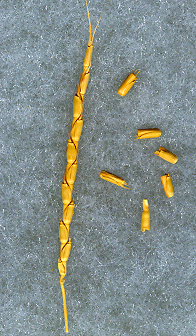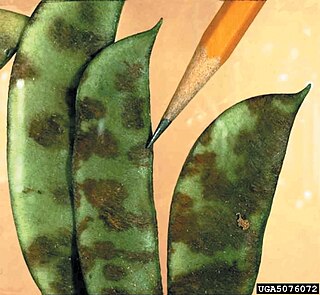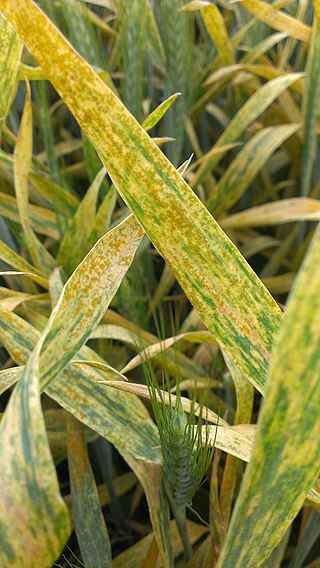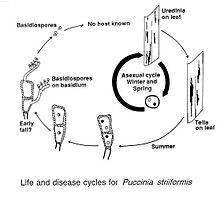
The oat, sometimes called the common oat, is a species of cereal grain grown for its seed, which is known by the same name. Oats are used for human consumption as oatmeal, including as steel cut oats or rolled oats. They appear to have been domesticated as a secondary crop as their seeds resembled those of other cereals closely enough for them to be included by early cultivators. Oats are a nutrient-rich food associated with lower blood cholesterol and reduced risk of human heart disease when consumed regularly. One of the most common uses of oats is as livestock feed; the crop can also be grown as groundcover and ploughed in as a green manure.

Rusts are fungal plant pathogens of the order Pucciniales causing plant fungal diseases.

Triticale is a hybrid of wheat (Triticum) and rye (Secale) first bred in laboratories during the late 19th century in Scotland and Germany. Commercially available triticale is almost always a second-generation hybrid, i.e., a cross between two kinds of primary (first-cross) triticales. As a rule, triticale combines the yield potential and grain quality of wheat with the disease and environmental tolerance of rye. Only recently has it been developed into a commercially viable crop. Depending on the cultivar, triticale can more or less resemble either of its parents. It is grown mostly for forage or fodder, although some triticale-based foods can be purchased at health food stores and can be found in some breakfast cereals.
The cereal grain wheat is subject to numerous wheat diseases, including bacterial, viral and fungal diseases, as well as parasitic infestations.

Stem rust, also known as cereal rust, black rust, red rust or red dust, is caused by the fungus Puccinia graminis, which causes significant disease in cereal crops. Crop species that are affected by the disease include bread wheat, durum wheat, barley and triticale. These diseases have affected cereal farming throughout history. The annual recurrence of stem rust of wheat in North Indian plains was discovered by K.C. Mehta. Since the 1950s, wheat strains bred to be resistant to stem rust have become available. Fungicides effective against stem rust are available as well.

Wheat leaf rust is a fungal disease that affects wheat, barley, rye stems, leaves and grains. In temperate zones it is destructive on winter wheat because the pathogen overwinters. Infections can lead up to 20% yield loss. The pathogen is a Puccinia rust fungus. It is the most prevalent of all the wheat rust diseases, occurring in most wheat-growing regions. It causes serious epidemics in North America, Mexico and South America and is a devastating seasonal disease in India. P. triticina is heteroecious, requiring two distinct hosts.

Cladosporium is a genus of fungi including some of the most common indoor and outdoor molds. Some species are endophytes or plant pathogens, while others parasitize fungi.

Hordeum jubatum, with common names foxtail barley, bobtail barley, squirreltail barley, and intermediate barley, is a perennial plant species in the grass family Poaceae. It occurs wild mainly in northern North America and adjacent northeastern Siberia. However, as it escaped often from gardens it can be found worldwide in areas with temperate to warm climates, and is considered a weed in many countries. The species is a polyploid and originated via hybridization of an East Asian Hordeum species with a close but extinct relative of Californian H. brachyantherum. It is grown as an ornamental plant for its attractive inflorescences and when done flowering for its inflorescence.

Aegilops tauschii, the Tausch's goatgrass or rough-spike hard grass, is an annual grass species. It is native to Crimea, the Caucasus region, western and Central Asia, Afghanistan, Pakistan, the western Himalaya, and parts of China, and has been introduced to other locales, including California.

Puccinia hordei is a species of rust fungus. A plant pathogen, it can cause leaf rust of barley, also known as brown rust of barley. It was originally found on the dry leaves of Hordeum vulgare in Germany.
Barley stripe rust is a fungal disease of barley caused by Puccinia striiformis f. sp. hordei. a forma specialis of Puccinia striiformis. It was first detected in the United States in 1991, in northern and eastern Idaho in 1993, In 1995 it was detected for the first time in western Washington and western Oregon and is currently considered to be well established there. The disease initially develops at a small loci within a field and spreads rapidly and has caused significant losses in areas where climatic conditions are cool and wet.

Ug99 is a lineage of wheat stem rust, which is present in wheat fields in several countries in Africa and the Middle East and is predicted to spread rapidly through these regions and possibly further afield, potentially causing a wheat production disaster that would affect food security worldwide. In 2005 the noted green revolution pioneer Norman Borlaug brought great attention to the problem, and most subsequent efforts can be traced to his advocacy. It can cause up to 100% crop losses and is virulent against many resistance genes which have previously protected wheat against stem rust.

Puccinia coronata is a plant pathogen and causal agent of oat and barley crown rust. The pathogen occurs worldwide, infecting both wild and cultivated oats. Crown rust poses a threat to barley production, because the first infections in barley occur early in the season from local inoculum. Crown rusts have evolved many different physiological races within different species in response to host resistance. Each pathogenic race can attack a specific line of plants within the species typical host. For example, there are over 290 races of P. coronata. Crops with resistant phenotypes are often released, but within a few years virulent races have arisen and P. coronata can infect them.

Puccinia recondita is a fungus species and plant pathogen belonging to the order of Pucciniales and family Pucciniaceae.

Colletotrichum is a genus of fungi that are symbionts to plants as endophytes or phytopathogens. Many of the species in this genus are plant pathogens, but some species may have a mutualistic relationship with hosts.

Wheat yellow rust, also known as wheat stripe rust, is one of the three major wheat rust diseases, along with stem rust of wheat and leaf rust.
Ruth Florence Allen (1879–1963) was an American botanist and plant pathologist and the first woman to earn her Ph.D. in botany from the University of Wisconsin. Her doctorate research focused on the reproduction and cell biology of ferns, particularly the phenomenon of apogamy. Later in her career, Allen shifted her focus to plant pathology. Her major contribution to the field of mycology was furthering the understanding of rust fungi, a group of economically important plant pathogens. Allen completed many studies on Puccinia graminis, once considered a catastrophically damaging disease-causing agent in cereal crops before the discovery of current management measures.

Helicobasidium is a genus of fungi in the subdivision Pucciniomycotina. Basidiocarps are corticioid (patch-forming) and are typically violet to purple. Microscopically they have auricularioid basidia. Asexual anamorphs, formerly referred to the genus Thanatophytum, produce sclerotia. Conidia-bearing anamorphs are parasitic on rust fungi and are currently still referred to the genus Tuberculina.

Agriculture in Finland is characterized by the northern climate and self-sufficiency in most major agricultural products. Its economic role is declining in terms of GNP and employment in primary production, but together with the food industry and forestry with which it is linked, it forms a significant part of the Finnish economy. The number of farms has steadily declined for the last decades. Between 2000 and 2012 their number fell from almost 80,000 in 2000 to about 60,000, while the amount of arable land has slightly increased to a total of almost 2.3 million hectares. Agriculture employed 125,000 people in 2010, which is a drop of 30 percent from 2000.
Diane G. O. Saunders is a British biologist and group leader at the John Innes Centre and an Honorary Professor in the School of Biological Sciences at the University of East Anglia. Her research investigates plant pathogens that pose a threat to agriculture. She was awarded the Rosalind Franklin Award by the Royal Society in 2022.















